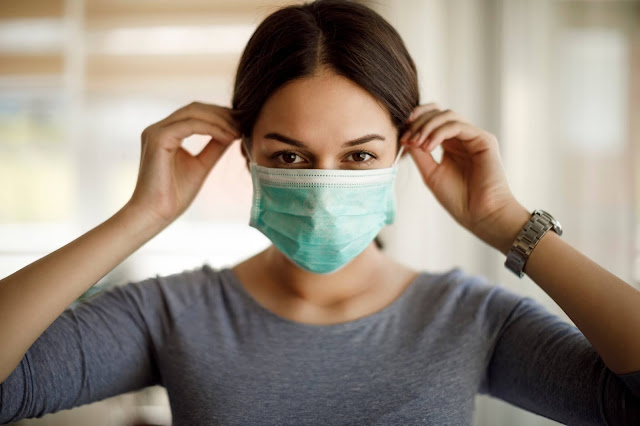MASKNE
In an effort to slow the spread of COVID-19, wearing a face mask has become part of our daily routine and is unavoidable. It’s now required in all public places, such as restaurants and grocery stores, and almost at all times as a barrier against the new coronavirus that spreads through respiratory droplets.
If you develop breakouts from wearing a mask, you’re not alone. This condition, known as “maskne” (mask acne), is a common side effect of using a mask and wearing it for prolonged periods.
Maskne doesn’t simply cause pimples, though. It may also result in skin issues including redness, bumpiness, and irritation and chaffing.
If you’re concerned about maskne, this is definitely the article you should read. We’ll explore the potential causes, as well as ways to treat and prevent it.
Healthcare and other front-line workers are most at risk because their masks are tighter-fitting and they are wearing them longer. Doctors have reported an increase in acne flare-ups in people outside of healthcare as well.
What to know about maskne skin conditions
Generally, “maskne” is an umbrella term for several skin conditions that can be caused by wearing a face mask or covering. It can include:
Acne. Acne happens when your pores become clogged with oil, dead skin cells, and dirt. It can cause pimples, whiteheads, or blackheads.
Rosacea. If you have rosacea, wearing a mask may cause flare-ups. This can lead to pimples and redness.
Contact dermatitis. Contact dermatitis occurs when you’re allergic or sensitive to the material of your mask. It can result in a red rash, along with irritation and blisters.
Folliculitis. Folliculitis, or an infection of your hair follicles, causes bumps that look like an acne breakout. You might also experience itchiness or pain.
If you already have one of these conditions, you may be more prone to developing maskne.
How to treat maskne
It’s essential to keep wearing a face mask, even if you have maskne. Keeping your mouth and nose covered is one of the best ways to protect yourself and those around you from COVID-19.
There are several ways to treat maskne symptoms. Let’s take a closer look at each step.
Wash your face regularly
During the pandemic, continue following your regular skin care routine to keep your skin healthy.
This includes washing your face:
once in the morning
once at night, before going to bed
after sweating or wearing a mask
When washing your face, use lukewarm water. Pat your skin dry with a clean towel. Avoid rubbing your skin as this may cause irritation.
Use a gentle cleanser
A gentle cleanser can help remove excess oil, sweat, and bacteria. Avoid cleansers that contain alcohol or perfume. These ingredients can cause irritation and make it harder for your symptoms to heal.
If your maskne is more severe, try a medicated cleanser with benzoyl peroxide or salicylic acid.
If you have sensitive skin, ask your doctor or dermatologist about the best type of medicated cleanser for your skin.
Use a noncomedogenic moisturizer
After washing your face, apply a moisturizer to keep your skin hydrated. Use a noncomedogenic product, which likely won’t block your pores.
Apply cortisone cream and moisturizer with ceramides
If your maskne mostly involves irritation and raw skin, you may want to apply a mild cortisone cream to the area together with a moisturiser that contains ceramides. This can help protect your skin and relieve itching and irritation.
Take a break from makeup
Skip the makeup while you’re treating maskne. Beauty products such as foundation, concealer, and blush can clog your pores and prolong healing.
Maskne prevention tips
Since you’ll likely need to continue wearing a face mask in public for the foreseeable future, it might help to follow these maskne prevention tips.
Wash fabric masks after every use
Never reuse a cloth mask without first washing it. Use unscented hypoallergenic laundry detergent, then let it dry completely.
Apply a topical antibiotic cream
It’s not uncommon for bacteria to build up under a mask, which can lead to acne. To prevent this, dermatologists often recommend applying a topical antibiotic cream or gel on your skin before putting on your face mask.
Toss disposable masks after each use
After wearing a disposable mask, throw it away. Consider keeping several face masks on hand in case you need a fresh one.
Remove your mask every 4 hours
The American Academy of Dermatology Association recommends removing your mask for 15 minutes every 4 hours. This will help give your skin a break.
You should remove your face mask only when you can practice physical distancing with people who aren’t in your household. It’s also important to wash your hands before taking a mask break. Please also make sure it is safe sound to remove your mask.
Apply a moisturiser before wearing a mask
If your skin tends to be dry, a mask may cause irritation. Applying a noncomedogenic moisturizer can help hydrate your skin. A moisturiser can also serve as a barrier between your skin and the mask.
Choose the right mask
To avoid skin issues, be mindful of the type of mask you wear.
Try to wear a face mask that:
fits snugly, but not too tight
has two or more layers of fabric
is made of natural, soft fabric (like cotton)
Avoid masks made of synthetic fabrics, such as nylon or rayon. These materials can irritate the skin.
Wash your face after wearing a mask
Once you’re back at home, wash your face with a gentle cleanser. Follow with a moisturiser to protect your skin. Washing your face is especially important after sweating while wearing a mask.
End note
Although maskne can be frustrating, it’s important to keep wearing face coverings during the COVID-19 pandemic. Regular face-washing, moisturizing, and wearing the right type of mask may help prevent skin problems.
If your maskne is more severe, or if it still persists after trying these recommendations, be sure to follow up with your dermatologist or healthcare provider.




